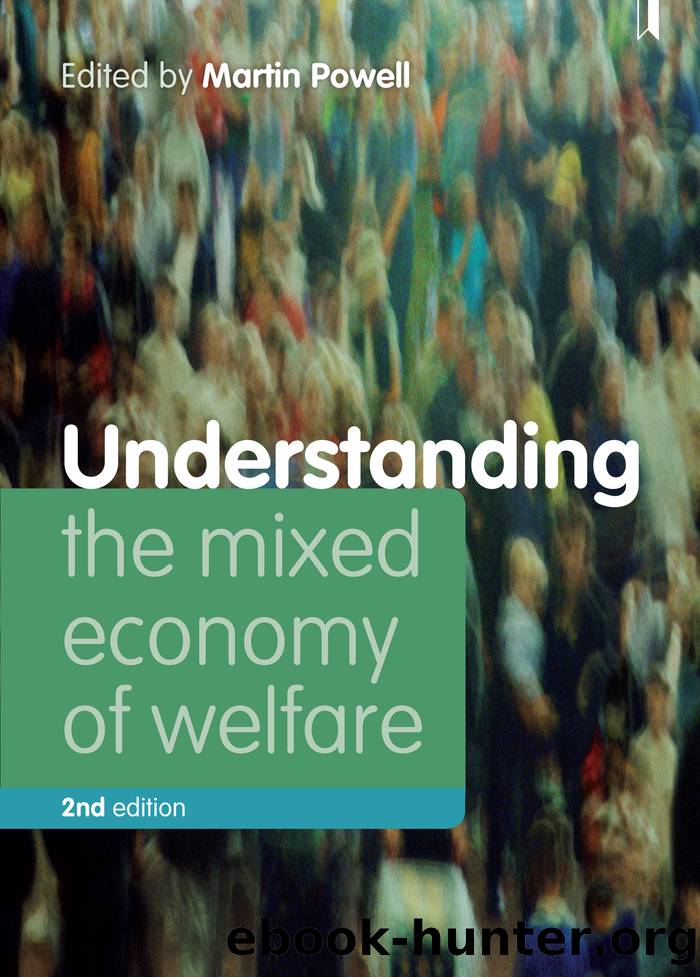Understanding the Mixed Economy of Welfare by Martin Powell

Author:Martin Powell [Powell, Martin]
Language: eng
Format: epub
ISBN: 9781861347596
Goodreads: 13221575
Publisher: Policy Press
Published: 2007-02-27T00:00:00+00:00
Future prospects
It is worth noting that the role of the voluntary sector in the mixed economy of welfare has always attracted controversy from across the political spectrum, and particularly from those associated with the âtraditionalâ left and right. The Left has sometimes been wary of the sectorâs role insofar as it is seen as a Trojan Horse for privatisation, softening up opposition to the abandonment of the vision of universal (state-led) public service; while for some within the sector the delivery role is perceived to undermine the âpurityâ of independent social action (Rochester, 2013). Conversely, the right is wary of the dilution of free market principles and seeks to challenge special pleading for âgood causesâ, clientelism or the growth of a âcharity industryâ (Whelan, 1999). But as this chapter makes clear, the history of the voluntary and community sector in the mixed economy of welfare shows such claims to be simplistic. A âthird wayâ interpretation posits that the sector could be something of a saviour of welfare, with it being well placed to pioneer and maintain associational and relational welfare, advance co-production, and enhance personalisation and accountability (Pestoff et al, 2012).
Meanwhile many voluntary sector commentators have been critical of both the embrace by the state of the voluntary sector within the mixed economy of welfare in the expansionary years of New Labour (Carmel and Harlock, 2008), as well as of the subsequent cuts and recasting of that role following the financial crisis, recession and the post-2010 austerity programme (Milbourne and Cushman, 2015). Again, as this chapter demonstrates, the aggregate picture of the sectorâs experience as a whole should caution against deep pessimism. There is evidence of both stability and limited growth in particular sub-sectors, suggesting a certain degree of mutual dependence and indeed partnership underlying the mixed economy of welfare. Nor is it clear that, despite some high-profile casualties, those parts of the sector directly engaged in the mixed economy of welfare are irreconcilably damaged by involvement in the ways suggested by critics. Although these fears may come to be realised â and there are good reasons to remain cautious, including in the various ways that the changes to public services may have as much impact on service users and citizens â there insufficient empirical evidence to be confident about the future trajectory.
Indeed, the most salient feature of the current juncture is uncertainty, following the upheavals of the vote to leave the European Union in June 2016 and the relatively inconclusive outcome of the snap general election of June 2017. Clearly the Conservative government under Theresa May, and arguably much of the machinery of central government, is preoccupied with one very big issue: Brexit. There seem to be no flagship programmes for public service reform. What remains of the domestic social policy agenda looks set to be dominated by the National Health Service (NHS), schools and possibly prisons, typically fields without a large voluntary and community sector presence.
In contrast, although the Coalition governmentâs leitmotif was deficit reduction, it still managed
Download
This site does not store any files on its server. We only index and link to content provided by other sites. Please contact the content providers to delete copyright contents if any and email us, we'll remove relevant links or contents immediately.
The Secret History by Donna Tartt(18849)
The Social Justice Warrior Handbook by Lisa De Pasquale(12142)
Thirteen Reasons Why by Jay Asher(8796)
This Is How You Lose Her by Junot Diaz(6794)
Weapons of Math Destruction by Cathy O'Neil(6146)
Zero to One by Peter Thiel(5686)
Beartown by Fredrik Backman(5599)
The Myth of the Strong Leader by Archie Brown(5425)
The Fire Next Time by James Baldwin(5249)
How Democracies Die by Steven Levitsky & Daniel Ziblatt(5128)
Promise Me, Dad by Joe Biden(5087)
Stone's Rules by Roger Stone(5026)
A Higher Loyalty: Truth, Lies, and Leadership by James Comey(4845)
100 Deadly Skills by Clint Emerson(4840)
Rise and Kill First by Ronen Bergman(4704)
Secrecy World by Jake Bernstein(4646)
The David Icke Guide to the Global Conspiracy (and how to end it) by David Icke(4625)
The Farm by Tom Rob Smith(4438)
The Doomsday Machine by Daniel Ellsberg(4416)
